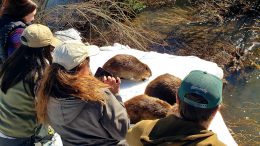Late last February I joined a group of volunteers to deliver a family of beavers to a creek in the Cascade-Siskiyou National Monument in southern Oregon. Snow blanketed the ground, glittering in the winter sun as we strapped on snowshoes.
Jakob Shockey, founder of the nonprofit Project Beaver, called out, “Who wants to carry a beaver?” Five of them — mom, dad, and three offspring — rested beside him, each safely ensconced in a canvas bag for their protection.
Volunteers helped each other strap the bags onto frame packs. The adult beavers weighed nearly 60 pounds, and the unwieldy packages bulged awkwardly, but the animals didn’t stir once strapped in place.
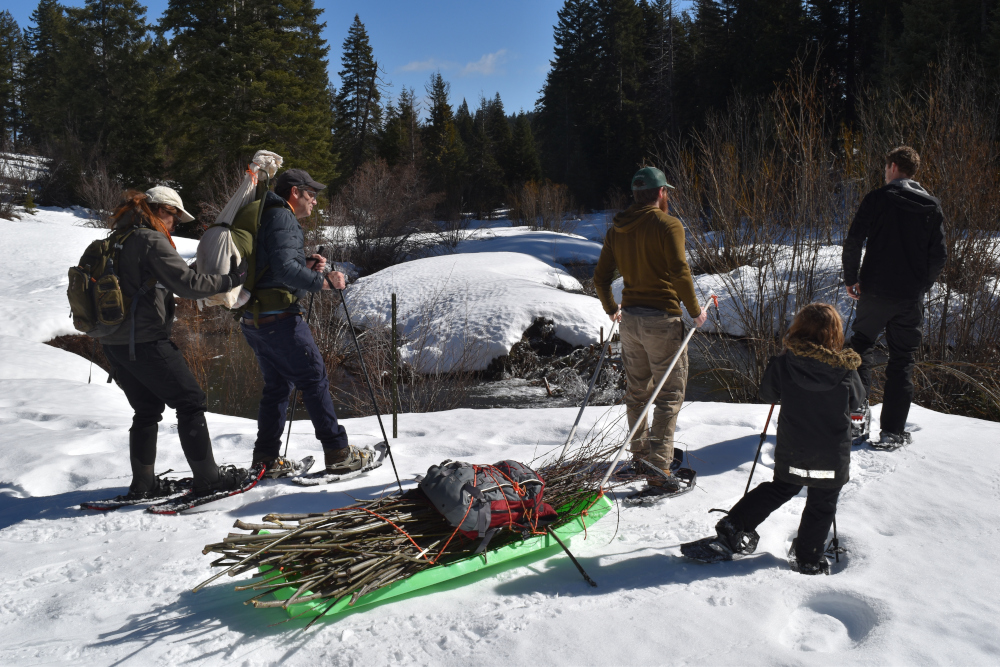
Once abundant, beavers were mostly trapped out of the Cascade-Siskiyou region over a century ago. As they disappeared, so did the verdant mountain meadows they helped maintain.
Project Beaver has been working with Bureau of Land Management biologists, nonprofits, private landowners, and dozens of volunteers to bring beavers back to this landscape. But first they needed to make conditions more hospitable.
“There are so many hands and hearts that have gone into cutting branches, dragging them down to the creek, planting willows in spring and fall,” says Jeanine Moy, director of the Vesper Meadow Education Program, which operates on private land nearby.
It had taken six years to set the table for the beaver family. Now, we all hoped, these expert engineers would go to work transforming fields into the wet meadows they once were.
We set off for the creek in a ragged train, snowshoes crunching against the snow.
Mountain Meadows in Decline
Here’s how to degrade a wet meadow:
First, trap out all the beavers. Then displace the people with intimate knowledge of the ecosystem. Log the upland forests. Build canals to divert water. Bring in the cows, armed with weed seeds on their hides and in their poop. Apply broadly.
Over decades the creek that flows through Vesper Meadow had “more or less turned into a ditch,” says Chris Volpe, a BLM fish biologist. Instead of seeping into the surrounding land, water shunts through a narrow “V,” cutting the banks ever steeper and making the water flow ever faster.
Reversing this vicious cycle isn’t easy. Beavers, famed ecosystem engineers, could help simply by going about their natural business. But in many cases, streams need rehabilitation before they can flourish.
An idealistic couple purchased the Vesper Meadow acreage specifically to create a holistic stewardship project and restore the wet meadows. They hired Moy to lead it.
Vesper Meadow is a place and a project, but it’s also an idea.
“When Vesper Meadow started, there was this vision for people to come together and have this positive relationship with the land,” says Moy. People can engage in whatever way they feel called, whether monitoring plants and butterflies, attending a workshop, or creating art.
In 2018 volunteers started planting hundreds of willow stakes — a favored food and construction material of beavers — each spring and fall. Moy spent two years navigating a complex permitting process before they could do any work in the stream itself.
Around the same time, Volpe and the monument ecologist began surveying the monument for places to plant beavers. In 2022 Shockey’s crew began building “beaver dam analogs” at Vesper Meadow and strategic locations in the monument. These structures — BDAs, in restoration parlance — emulate the dams and lodges that beavers build. They act like speed bumps, slowing and spreading water behind them.
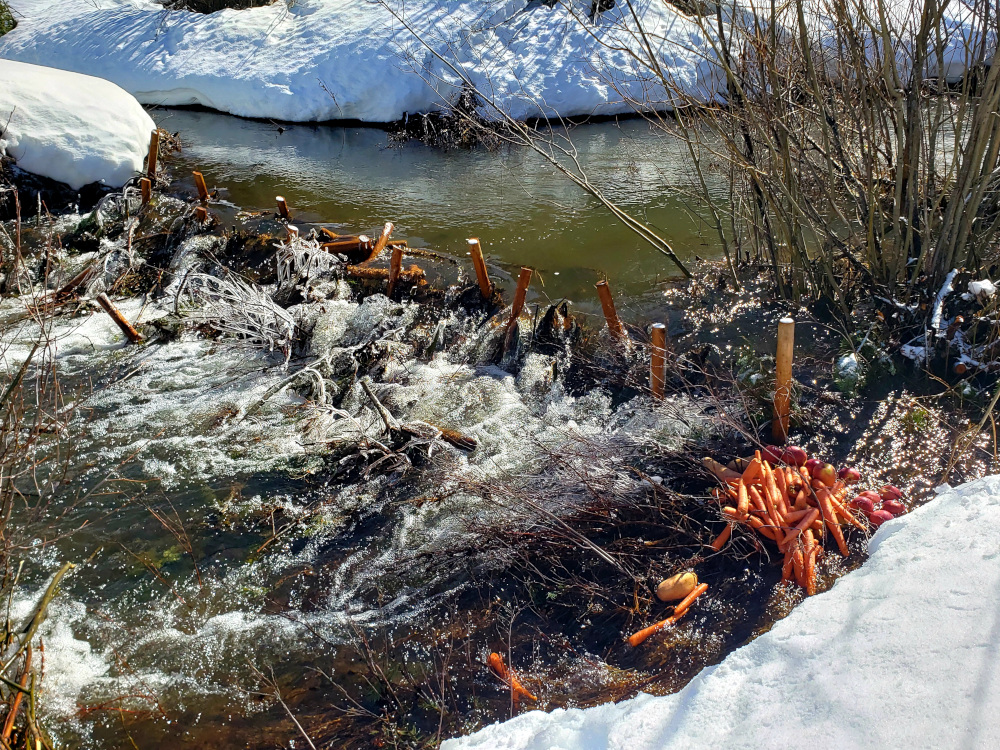
With help Project Beaver has built over 100 BDAs in Vesper Meadow and adjacent public land. I spotted several at the release site: lines of angled posts pounded into the creek bed with slender branches woven between them. The BDAs created little waterfalls, with quiescent pools behind them.
BDAs are a means to an end, says Shockey. “If we can get willows going and [create] some [pockets of] deep water, then that’s something that we can move beavers into.”
From Nuisance to Neighbor
Beavers are often called keystone species because their presence in an ecosystem unlocks so many benefits. Their dams kick off a virtuous cycle, slowing and storing water. Wetland plants take root, which feed beavers and shelter songbirds and attract insects. Biodiversity spikes when beavers are around.
But for all the good they do, beavers sometimes damage trees that people want to keep standing, and their constructions can block waterways and flood properties.
The family we released was rescued from an irrigation ditch west of the monument. Left alone, these “nuisance beavers” faced an uncertain fate — perhaps even death.
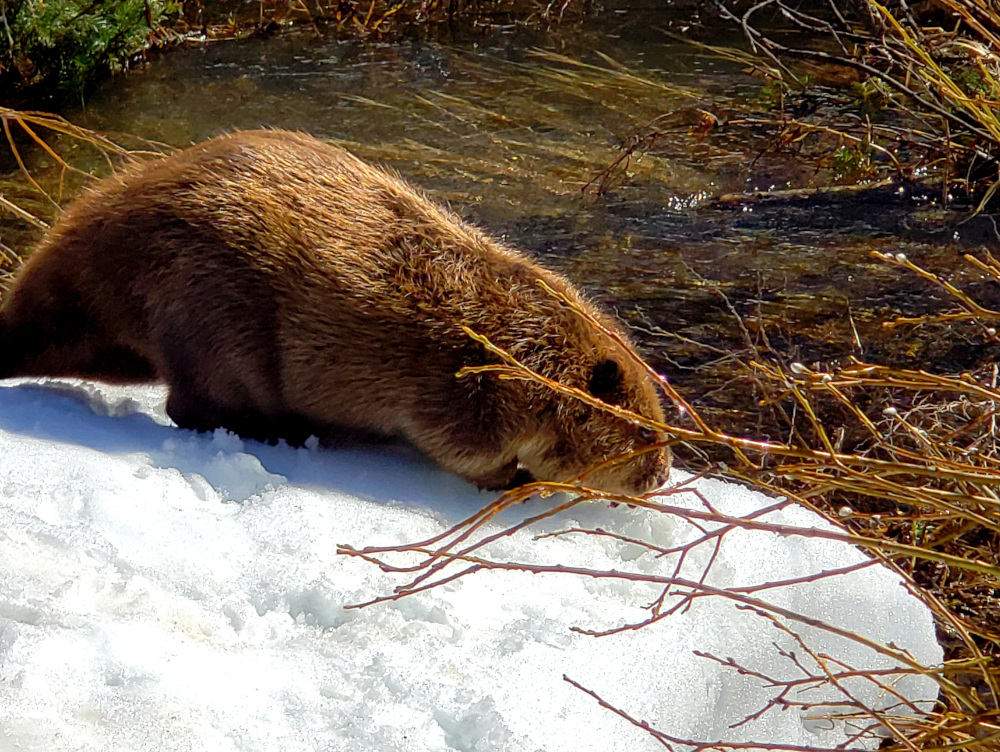
Luckily the river-loving rodents are undergoing a brand refresh in Oregon, where they’d previously been lumped into the same category as predators. Last year the Oregon legislature passed a bill that reclassified beavers that dwell on private land as “furbearers.” Now landowners must consider nonlethal methods of control, and they must obtain a permit and report any beaver they “take” to the state’s wildlife agency.
This year the state is considering two new bills. One would ban trapping on public land where waterways are deemed “impaired” by the state. The second would create a grant program landowners could use to pay for nonlethal controls.
Beaver damage can be mitigated — trees can be wrapped with wire mesh; devices can be installed in beaver dams that allow some water to flow downstream — but those strategies cost money.
“If there were these grant funds to help people coexist with beavers, we could be solving the problems,” explains Shockey. “Beavers wouldn’t have to be uprooted from where they actually have chosen to live and moved as refugees up into the mountains.”
These bills have bipartisan support, says Representative Pam Marsh, who has championed every beaver bill.
“Beavers are cute and interesting, but they are [also] really effective operators on the landscape,” she says. “Especially at a time of drought, we should really be cultivating beavers to do the work they are meant for.”
As climate change accelerates, the more beavers we can deploy, the better off we’ll all be.
How Beavers Could Help a Beleaguered Butterfly
Last summer I joined another small crew on a butterfly survey not far from Vesper Meadow. We were hunting for the Klamath Mardon skipper, an imperiled butterfly that lives in these mountain meadows and nowhere else. This little insect is about the size of my fingernail, with a stout, hairy body and mottled, tawny wings.
We fanned out across a field, walking slowly in parallel, and the world compressed into the swaying stems of grasses going to gold in the July heat. Our movements stirred up little bits of color: I saw checkerspots, blues, and other skippers, but no Mardons.
The Cascade-Siskiyou National Monument was designated for its outstanding biodiversity. Nearly 120 species of butterflies have been documented in its meadows, forests, and savannahs. But a long legacy of grazing, coupled with climate change, is making it harder for some butterflies to thrive here.
Klamath Mardon skippers are especially sensitive. They’re only found in wet meadows, where they lay their eggs on native grasses. Caterpillars feed on the tender tips of stems, which puts them in the crosshairs of cows’ maws. Cows also trample eggs and spread invasive weeds that thrive in warmer, drier conditions.
Season all of this with climate change and you have a recipe for extinction. The trend throughout the monument is more rain, less snow; higher high temperatures; longer droughts; scarier wildfires.
Vesper Meadow is working with monument biologists to exclude cows from Mardon skipper meadows, and beavers are a key part of the triage effort.
The gushy, wet meadows beavers maintain are “natural sponges,” saturating in times of plenty, acting as natural reservoirs during drought.
“Beavers can’t make more water, but they can help to store it on the landscape,” says Volpe.
A Climate of Uncertainty
Down by the creek, we unveiled the beavers. Youngsters are tolerant of humans, Shockey assured us, so we took a few minutes to admire them: their soft brown fur, massive, fan-shaped hind feet and long, fingernail-like claws — ideal for grasping and grooming. One by one, they waddle-plopped into the water, suddenly looking much smaller.
We watched them explore their new digs while Shockey piled apples, sweet potatoes, and carrots near the bank. Soon enough the beavers would be on their own.
Life in a high mountain stream is not easy. Any of these fat rodents would make a nice lunch for a cougar. These beavers could also simply choose to leave.
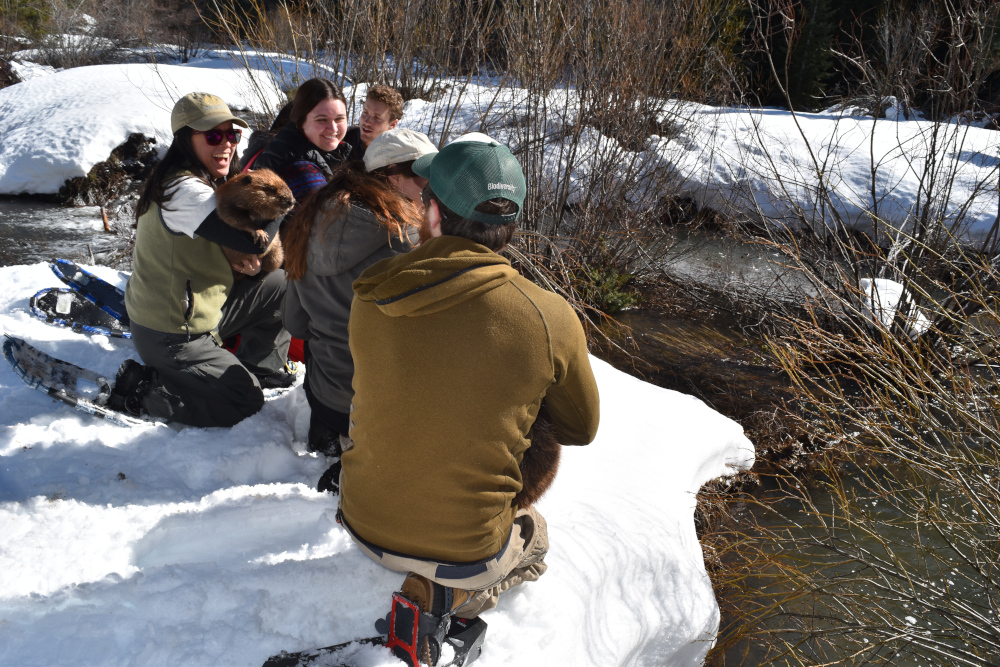
Moy says it would be “wondrous” if the beavers stick around; in any case, there’s still more work for humans to do.
That work may progress more slowly than anyone would like. The federal grant funding Moy planned to use to build more beaver structures and host workshops at Vesper Meadow has evaporated. And the Trump administration has frozen the $220,000 grant Project Beaver was using to install beaver structures throughout the monument.
“We’re going to have to get scrappy and keep working with the community,” says Moy. “We’re realizing more than ever how important it is to build local networks and mutual aid.”
I’m betting they’ll find a way to ride out the tectonic chaos of the Trump administration. Over a dozen people chose to drive up from the valley on a Tuesday morning to strap on snowshoes and witness beavers sliding into a creek. Last summer nearly 100 people showed up to take part in a beaver scavenger hunt in the monument.
I’m convinced people will keep showing up for beavers, but also for each other and for themselves. Doing tangibly good work, I’ve found, is the antidote to despair. In this way, restoration can be revolutionary.

Previously in The Revelator:
Urban ‘Microrewilding’ Projects Provide a Lifeline for Nature

